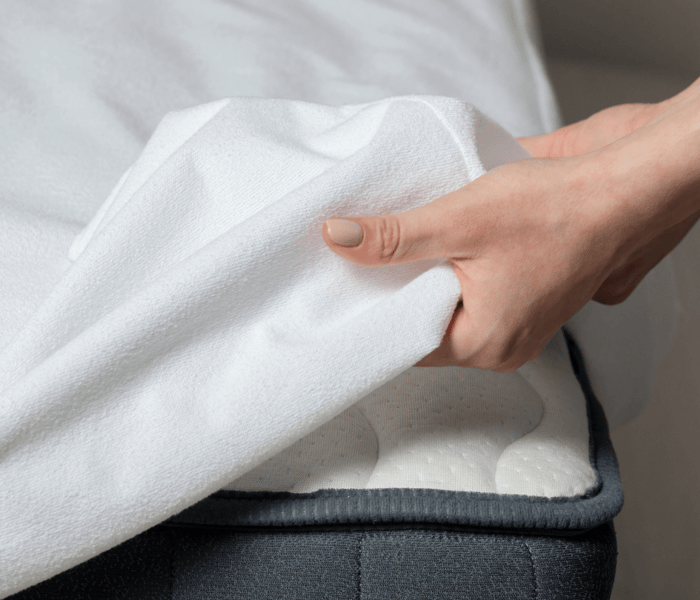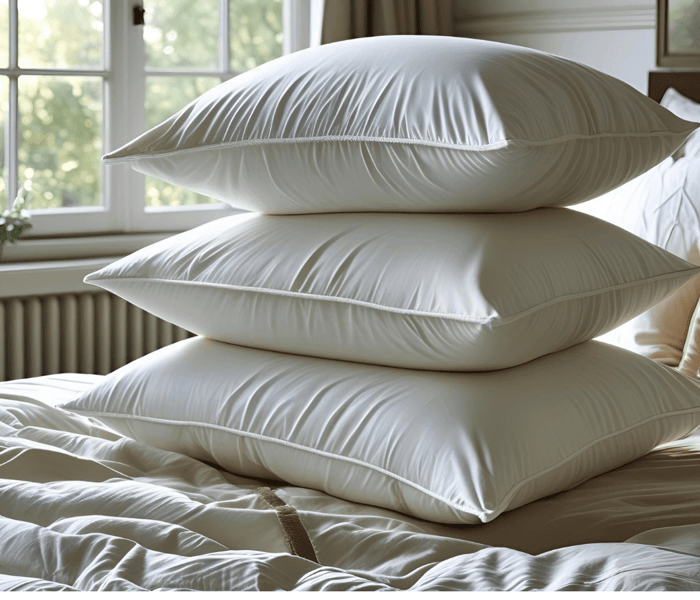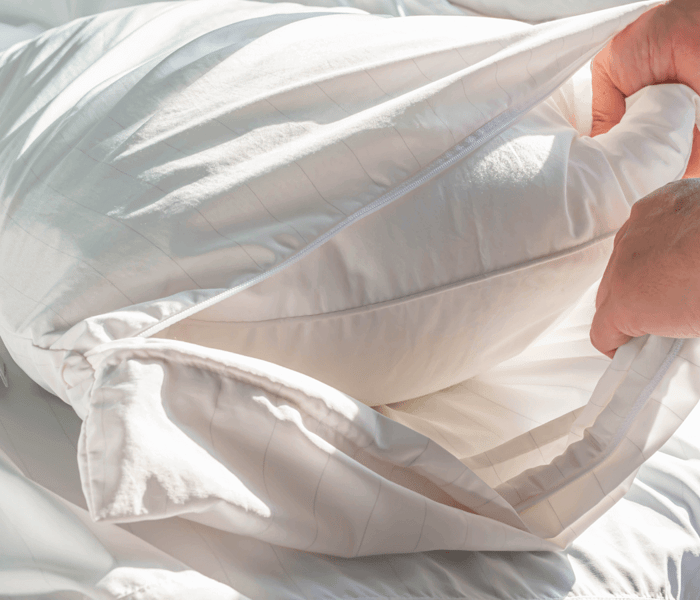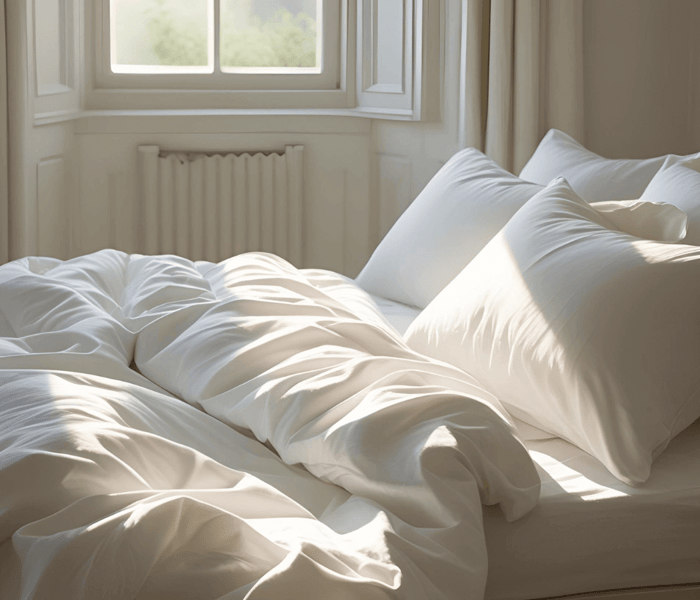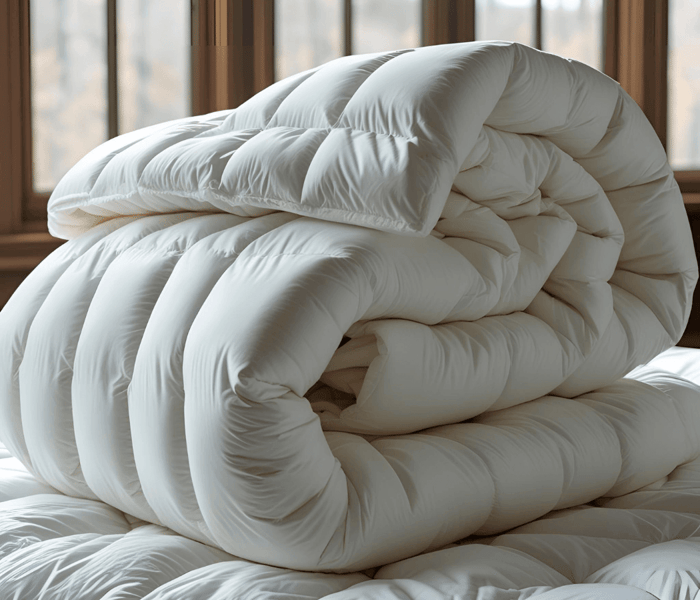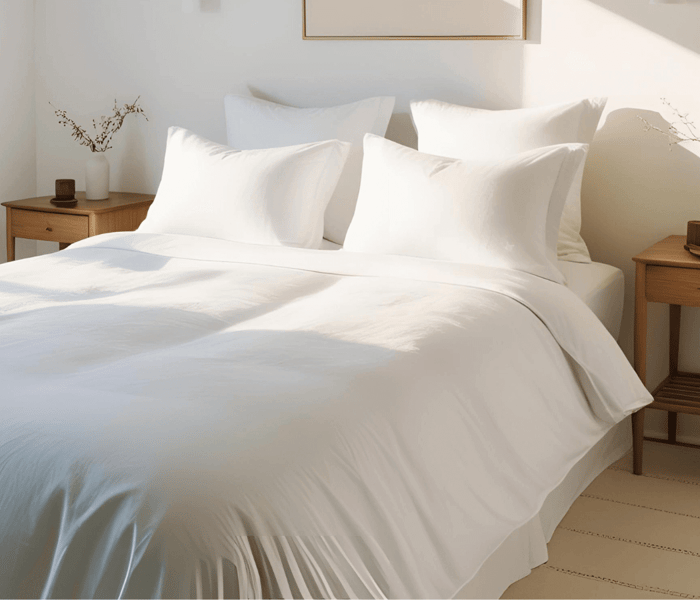Table of Contents
Short on time?
Scroll to the bottom for our Ultimate Airbnb Bedding Cheat Sheet.
 One of the most important investments you can make for your Airbnb rental property is the bed. At FIX Linens we have made it our top priority to become experts in all things bed-related. So, whether you are just refreshing or building a bed from the ground up, we're here to help with all the information you could possibly need in one place. Welcome to The Ultimate Bedding Setup Guide for Airbnb & Short-Term Rentals.
One of the most important investments you can make for your Airbnb rental property is the bed. At FIX Linens we have made it our top priority to become experts in all things bed-related. So, whether you are just refreshing or building a bed from the ground up, we're here to help with all the information you could possibly need in one place. Welcome to The Ultimate Bedding Setup Guide for Airbnb & Short-Term Rentals.

Bed frames
Everything starts with a solid foundation. Make sure you build the best bed at the most basic level with a quality bed frame. When choosing a bed frame for your Airbnb, consider the following key factors to ensure durability, guest comfort, and safety:
Cost and Longevity: Balance affordability with quality to maximize lifespan and guest comfort, reducing the need for frequent replacements. Look for a solid, well-built frame made from durable materials like hardwood or high-quality metal to withstand frequent use. Avoid cheaper options such as pressed wood or MDF, which will lead to more frequent replacements and cost more over time.
Ease of Assembly: Select a bed frame that is easy to assemble and disassemble for cleaning, maintenance, or replacement.
Design and Style: Opt for a neutral, versatile style that complements various decor and will support decor changes or upgrades.
Storage Options: Consider frames with built-in storage, especially when outfitting a tight space. Frames that provide under-bed clearance are also beneficial for STR properties as guests can easily use them to stow suitcases during their stay.
Stability and Safety: Ensure the frame has a secure foundation, with no wobbly parts or sharp edges, and that it supports weight comfortably. Make sure to check the manufacturer’s information regarding how much weight is recommended, and keep in mind that guests come in all shapes and sizes. It’s best to err on the side of caution and purchase a bed frame that will support a variety of guests.
Maintenance and Cleaning: Choose a design that is easy to clean and maintain, with minimal crevices or fabric that traps dust. While fabric-covered frames are aesthetically pleasing, they might not be the best choice as they require additional measures of cleaning and sanitation between guests.
Replacement timeline
A quality bed frame can last between 10 to 20 years with proper care and maintenance. High-quality bed frames constructed of solid wood or sturdy metal can extend this lifespan, making them worthwhile investments for property owners.
To further maximize bed frame longevity:
Regularly check your frame for wear, tears and needed repairs. Always be on the look out for missing or loose screws, nuts and or bolts. If your frame has a slatted frame, consistently check each board for breaks or cracks. A metal frame should be inspected for any bending or loose welds.
For non-cloth materials, wiping down the bed frame and attached head or footboards should be part of between guest cleaning. If your frame includes fabric components, these should be vacuumed between guests and spot cleaned when necessary. Once a month, all frames should be deep cleaned by removing the mattress and box springs/foundation and vacuuming and wiping down the frame itself to remove any trapped dust or allergens.
Best Practice Guidelines- Bed Frames
- A thoughtfully selected and well-maintained quality bed frame will endure guest after guest and year after year while retaining its structure and appearance.
- Wipe down bed frames between guests and deep clean once a month.
- Inspect bed frames regularly for damage or needed repairs.
Mattresses
Mattress shopping can be daunting for most people. As a result, trying to select mattresses for countless unknown guests who all have their own preferences can seem not just overwhelming, but almost impossible. Get comfortable with selecting the perfect mattress for your Airbnb by considering factors such as materials, size, and price point.
Material: Choose a medium-firm mattress that appeals to a broad range of guests and provides good support for different sleep preferences. Opting for high-quality hypoallergenic materials such as memory foam, hybrid, or quality innerspring mattresses will withstand frequent use and provide a healthy and comfortable sleep for your guests. Consider mentioning your property’s mattress selection in your property’s listing. This will help guests make knowledgeable decisions about their stay.
Size: Match the mattress size to the room dimensions and your prospective guests. To attract a family, a large room might be better outfitted with multiple singles. For the master bedroom, a queen sized mattress is the happy medium for AIRBNB use, but if the master can accommodate a king- this is usually a feature that will attract many types of travellers.
Price Point: Because of their expense, investing in a quality mattress will save you money in the long run. Balance cost with quality; investing a bit more upfront can result in longer-lasting comfort. If purchasing all your mattresses at once, check with your retailer for volume discounts or look into wholesale options.
Replacement Timeline
The lifespan of a mattress in an Airbnb typically ranges from 5 to 10 years, but this number is just an estimate. The true duration of an STR mattress is dependent on variables such as usage, frequency, mattress quality, maintenance, and guest behavior. While a high-quality mattress may last 8-10 years, a lower-quality or heavily used mattress may need replacement after 5-7 years.
Make sure to keep an eye on the wear and tear of your property’s mattresses. A saggy mattress will lead to guest discomfort and falling reviews. We recommend replacing mattresses proactively to stay away from the bad review replacement cycle.
Once you make the original investment in your mattresses, come up with a replacement schedule that mirrors the use of your property and your budget. This not only ensures that mattress comfort will always meet your guests’ standards, but will also help you spread out replacement and avoid purchasing all mattresses at once.
Best Practice Guidelines - Mattresses
Invest in a high-quality medium-firm mattress.
Balance cost with quality.
Purchase mattresses based on room size and the property’s optimum occupancy.
Inspect mattresses regularly for wear and tear - don’t wait for negative reviews to prompt replacement.
Mattress protector
A mattress protector is a great investment for your STR property. With a low price point, this item yields valuable returns as it protects and extends the life of your mattress. When choosing a mattress protector for your Airbnb, consider these factors to ensure durability, hygiene, and guest comfort:
Waterproof and Spill-Resistant: Protects against spills, stains, and accidents, minimizing damage to your mattress that might otherwise prompt early replacement.
Breathable Materials: Look for protectors made from breathable fabrics to prevent overheating and promote better sleep.
Hypoallergenic: Choose options that resist dust mites, allergens, and bacteria to enhance hygiene and accommodate sensitive guests.
Ease of Removal and Cleaning: The protector should be easy to remove and machine washable to facilitate regular cleaning.
Durability: Select high-quality, well-stitched protectors that can withstand frequent washing without losing effectiveness.
Certifications: Look for certifications like OEKO-TEX® to confirm safety standards.
Care
Wash your mattress protector approximately every 1 to 2 months. More frequent washing might be needed for the following:
High turnovers rates will contribute to decreasing time between washings.
Spills or stains should be treated or washed immediately.
If your property is pet-friendly, washing your mattress protector after each furry guest is a must to eliminate allergens.
Purchase and Replacement timeline
Purchase 1-2 protectors per bed.
Replace your mattress protector at least once every 1 to 2 years. Regular replacement helps maintain a hygienic sleeping environment and will prolong the lifespan of your mattress.
Reasons to replace more frequently:
Protector becomes stained, torn, or shows signs of wear
No longer fits snugly or securely
Odors or allergens that cleaning can't remove
Best Practice Guidelines - Mattress Protectors
- Use mattress protectors to increase the longevity of your mattresses.
- Wash protectors every 1 to 2 months or sooner if needed.
- Replace protectors every 1-2 years or if damaged or ill fitting.
Pillows
The importance of pillows is head and shoulders above many other elements you will select for your property. Choosing the right pillows means considering support, durability, and the best materials for your guests and property.
Comfort-and Support: Standard pillows typically come in three support options: soft, firm, and medium. To ensure all guests have a pillow that fits their needs, we recommend having a variety of pillows available. The best pillow depends upon what kind of sleeper your guest might be; while a side sleeper usually prefers a firmer pillow, a back sleeper usually does well with a medium pillow and a stomach sleeper usually prefers a softer pillow. While it is impossible to predict what kind of pillow each of your guests prefer, we recommend purchasing at least one softer pillow and one firmer pillow for each guest your property can accommodate.
Hypoallergenic Materials: Choose pillows made from hypoallergenic, breathable fabrics to reduce allergies and promote better air quality. If you choose to offer down pillows or even a material like latex, make sure you keep other options for allergen-sensitive guests in each bedroom or linen closet.
Durability: Invest in high-quality pillows that maintain their shape and support after multiple washes.
Size: Use pillow sizes that fit each bed size. Typically, king pillows are used with king size beds and standard are used for queen, full and twin beds.
Price: Balance cost with quality. While the initial investment in a higher quality option may be more than other options, take into account frequency of replacement. Chances are, a larger investment in the beginning will result in a longer-lasting pillow.
Care
Use pillow protectors to increase pillow longevity.
Inspect pillows periodically to ensure they remain supportive and comfortable for guests.
Check each pillow’s care tag for washing options. While some pillows can be machine washed, others may need to be hand-washed or spot cleaned.
Purchase and Replacement Timeline
Since pillows should be replaced every 1-2 years, create a budget friendly staggered replacement schedule that will fit your needs but will also ensure your guest’s comfort and the overall hygiene of your property.
Reasons to replace more frequently
Visible stains
Rips of tears
Persistent odors
Loss of shape or support
Best Practice Guidelines - Pillows
Providing a variety of pillows will cater to different guest preferences
Purchase Minimum:
1 pillow for each twin bed
2 pillows for each full, queen, and king bed
2 extra pillows for each king and queen
Replace pillows every 1 to 2 years.
Use pillow protectors for increased longevity.
Stock extra pillows in closets or linen closets that are suited for allergen-sensitive guests.
Pillow Protectors
Pillow protectors are a must-have for an STR property. Not only do they add longevity to your pillows by protecting them from spills, stains, dirt, and dust, but they also help pillows retain their shape and slow down the replacement cycle. Look for these features when shopping for pillow protectors for your AIRBNB property:
Hypoallergenic: Choose hypoallergenic materials that prevent dust mites, mold, and bacteria, creating a healthier sleeping environment for your guests.
Waterproof or Spill-Resistant: Protects pillows from sweat, spills, and stains.
Breathability: Opt for breathable fabrics to prevent overheating and ensure guest comfort.
Ease of Cleaning: Ensure the protector is removable and machine washable, making regular cleaning simple and effective.
Snug Fit: Match the protector size to your pillow size to and ensure they fit snugly without slipping.
Durable: Look for high-quality stitching and materials that will withstand frequent washing without tearing or losing effectiveness.
Certified: Check for safety certifications like OEKO-TEX or other non-toxic labels to ensure materials are safe for guests.
Care
Launder your pillow protectors approximately every 1 to 2 months.
More frequent washing might be needed for the following:
High turnovers rates- it's recommended to wash protectors more frequently—every 2 to 4 weeks—especially if multiple guests have stayed.
Spills or stains
If your property is pet-friendly, washing your pillow protectors after each furry guest is a must to eliminate allergens.
Replacement timeline
For your Airbnb, it's advisable to replace pillow protectors every 1 to 2 years.
Reasons to replace more frequently:
Protector becomes stained, torn, or shows signs of wear
No longer fits snugly or securely
Odors or allergens that cleaning can't remove
Best Practice Guidelines - Pillow Protectors
Purchase 1-2 protectors per pillow
Use pillow protectors to increase the longevity of your pillows
Wash protectors every 1 to 2 months or sooner if needed
Replace protectors every 1-2 years or if damaged or ill-fitting. Regular replacement ensures a clean, hygienic environment and helps maintain the longevity of your pillows and bedding.
Sheets
Bed sheets are not only a huge investment in your property, but the overall comfort of an STR bed. Make the best possible sheet selection by considering these important factors:
Material Quality: Choose soft, breathable fabrics like cotton (preferably percale or sateen), bamboo, or linen to provide a comfortable sleep experience.
Thread Count: 400 thread count is considered optimal for Airbnb sheets. This offers a good balance of softness and durability. Higher counts don’t guarantee higher quality and comfort.
Durability and Washability: Select sheets that can withstand frequent washing without fading, pilling, or losing quality.
Ease of Care: Look for wrinkle-resistant, quick-drying sheets for easy maintenance.
Fit and Size: Choose fitted sheets that have deep pockets which will prevent slippage. Always purchase sheets that align with the sizing of your mattress.
Allergy-Friendly: Opt for hypoallergenic options if possible, to cater to sensitive guests.
Color: Choose neutral, timeless colors that will match any decor and can be shared between multiple beds and or properties. Most host choose white bedding as it conveys a sense of cleanliness, quality, and professionalism, enhancing your guest's perception of the space.
Price Point: Balance quality with affordability; investing in durable, high-quality sheets reduces frequent replacements and enhances guest satisfaction.
Organization: Look for sheets that offer extra features such as color-coded size labels for easy sorting and faster turnovers.
Care
Always wash and inspect sheets thoroughly after each checkout.
Treat all stains immediately and take extra care to thoroughly clean sheets that have become noticeably or overly soiled. Check out our ultimate stain guide for more cleaning suggestions.
Purchase and Replacement Timeline
- A good rule of thumb for a STR start up is to purchase a minimum of 2 sheet sets per bed. This gives owners flexibility with property turnaround and also cuts down on wear and tear of each sheet set.
Purchasing one additional sheet set for each size bed within your property is always a good idea. These can be stored in a linen or owner's closet in case of emergency. For example, if a sheet set experiences a tear during a guest’s stay, owners would be able to take that set out of rotation without inconveniencing guests or impacting turnaround times.
Replace sheets every year or immediately if they show signs of wear, stains, or fading, even if not heavily used.
Following proper care instructions and a sheet rotation schedule can delay replacement.
Best Practice Guidelines - Sheets
Purchase multiple linen sets. Most pro hosts recommend 3 sets per bed. This cuts down on the daily wear and tear and can extend the time between sheet replacement.
Invest in high quality sheets which are more durable and withstand multiple washings.
Natural fiber sheets with a thread count of around 400 are best.
White sheets will insure a clean crisp look and will match any decor.
Look for sheets that offer easy sorting features like color-coded labels.
Launder sheets after each use and treat all stains immediately.
Replace sheets sets yearly or as needed.
Inspect sheet sets after each guest. Sheets with rips or tears or that retain odor or stains after treatment and washing should be taken out of rotation no matter their age.
Duvet Inserts/Comforters
A duvet insert/comforter is the top layer of your property’s bedding and is the very item that creates the loft and comfy look you want each bedscape to embody.
There's a lot of confusion in the bedding world around these terms, so let's break it down.
Duvet: The duvet itself is a bedding insert. A baffle or box-stitched piece filled with down or synthetic fiber enclosed in a fabric shell. It’s what you put inside a duvet cover.
Duvet Insert: Another name for duvet
Comforter - Traditionally, this was the name for a ready-to-use, as-is, blanket filled with synthetic fibers or down, sewn into a fabric shell. However, it's now become commonplace to use the word comforter interchangeably with duvet and duvet insert.
Duvet Cover: A removable fabric cover that encases the duvet/duvet insert/comforter. It functions like a pillowcase but for the duvet.
Summary: duvet, duvet Insert, and comforter are all words used to describe the item you put inside a duvet cover.
Considering the following key factors will ensure you select a duvet insert/comforter that fulfills your dreams and evokes those of your guests.
Fill Material: Choose high-quality down alternative for hypoallergenic needs and easier care.
Weight and Loft: Ensure the insert provides sufficient loft for comfort without being too heavy or stiff. Mid-weight comforts are a great, versatile choice for STR.
Breathability: Look for a comforter with a natural fiber outer shell, such as 100% cotton, to prevent overheating and promote good airflow during sleep.
Durability: Invest in quality inserts that maintain their shape and loft; high-quality fills last longer.
Size: consider sizing up if you plan on tucking your comforter under the sides of your mattress or if your mattress is over 16” thick. This will give you extra length to tuck or ensure that your comforter is long enough to cover your mattress.
Care
Wash or dry clean duvet inserts once a year.
If you have frequent guests, spills, or stains, wash more often as needed.
Use duvet protectors and covers to prolong the lifespan and maintain cleanliness, replacing the duvet insert when needed to ensure guest comfort and hygiene.
Purchase and Replacement Timeline
Purchase one duvet insert per bed.
Replace inserts/comforters every 3-5 years, depending on annual usage.
Replace sooner if you notice any filling clumps, shifts, or leaks, or if there are rips, stains, or tears.
Following proper care instructions can delay replacement.
Best Practice Guidelines - Duvet Inserts / Comforters
Initial investment should be one insert per bed.
Consider sizing up if you have a thicker mattress or plan to tuck in the sides.
Purchase an insert with a high-quality hypoallergenic fill.
A mid-weight loft provides a versatile insert for STR properties in a variety of climates.
Launder or dry clean inserts at least once a year.
Replace inserts every 3-5 years.
Inspect duvet inserts after each guess for signs of wear, tear, odors, or stains.
Duvet Covers
The purchase of a quality duvet cover is essential for not only the aesthetic of your bedscape, but also vital to protect the more costly duvet insert. Consider these factors when purchasing a duvet for your STR property.
- Material: Choose soft, breathable fabrics like 100% cotton (percale or sateen), linen, or bamboo for guest comfort. These materials feel and look luxurious and are gentle on the skin. Sateen weave, cotton covers are more wrinkle-resistant, which is essential for a clean finished look.
- Washability: Opt for duvet covers that are machine washable and durable enough to withstand frequent laundering.
- Quality Insert Closures: look for duvet inserts with corner snap-tabs versus traditional corner ties to prevent unsightly inverted corners, rips and tears to covers or inserts.
- Size and Fit: Ensure the cover matches the size of your duvet insert (Twin, Full, Queen, King) and fits snuggly for a wrinkle free fit. A duvet insert should lie flat inside the cover without crammed corners of edges.
- Easy to Clean: Look for covers with simple closers, such as 3-sided, triple-zip openings, and inside corner snaps to facilitate quick changing and secure closure during washing.
- Durability: Select high-quality, tightly woven fabrics that resist pilling, tearing, and fading over time.
- Style and Color: White complements any décor style, which will create a clean, fresh, and neutral look that appeals to a wide range of guests.
- Thread Count: 400 thread count is considered optimal, balancing softness and durability without sacrificing breathability.
Care
Wash duvet covers between each guest following the manufacturer's care instructions.
Inspect covers before laundering to identify and treat any stains or odors.
Purchase and Replacement Timeline
Purchase a minimum of 2 duvet covers per bed. This gives owners flexibility with laundering turn around and also cuts down on wear and tear of each cover.
Replace duvet covers every 1-2 years depending on annual usage.
Replace sooner if you notice wear, tears, stains or odors that do not come out after laundering.
Replace covers immediately if closures become damaged or worn out.
Following proper care instructions can delay replacement.
Best Practice Guidelines - Duvet Covers
Purchase at least 2 duvet covers per bed.
Choose a cover constructed of natural fabrics for breathability and a soft feel.
Invest in a quality cover that offers durability to sustain multiple washings.
Triple-zip closures and snap corner-tabs are ideal for quick changes and proper insert placement.
White is considered the industry standard for conveying a sense of cleanliness, quality, and professionalism, enhancing your guests' perception of the space.
Wash duvet covers after each guest.
Replace duvet covers every 1-2 years.
Inspect covers after each guest. Covers with rips or tears or that retain odor or stains after treatment and washing should be taken out of rotation no matter their age.
The Ultimate Airbnb Bedding Cheat Sheet
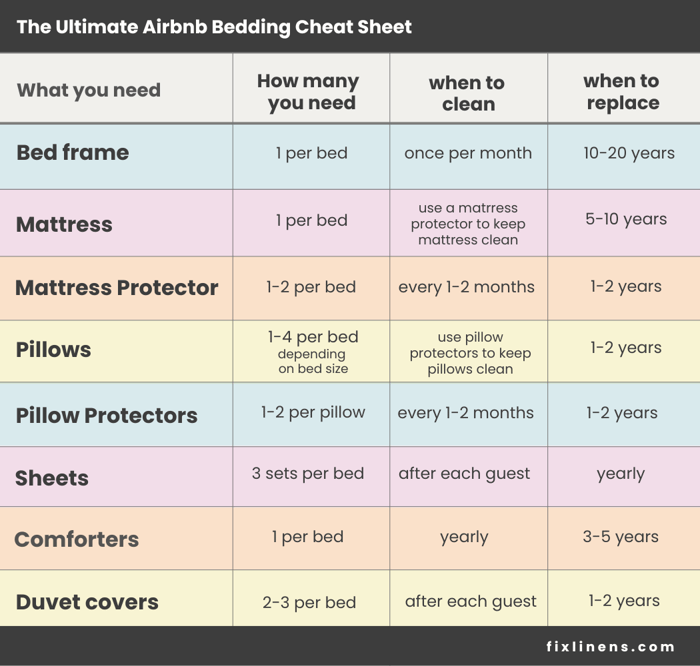
Ready to build your Short-Term Rental beds? The FIX Linens Bedding System was designed for Airbnb hosts. We're here to help you stock up with our 35% off everyday Volume Discounts.
Visit fixlinens.com for more info.
Written by: Cary Ballard - Freelance Writer for FIX Linens


